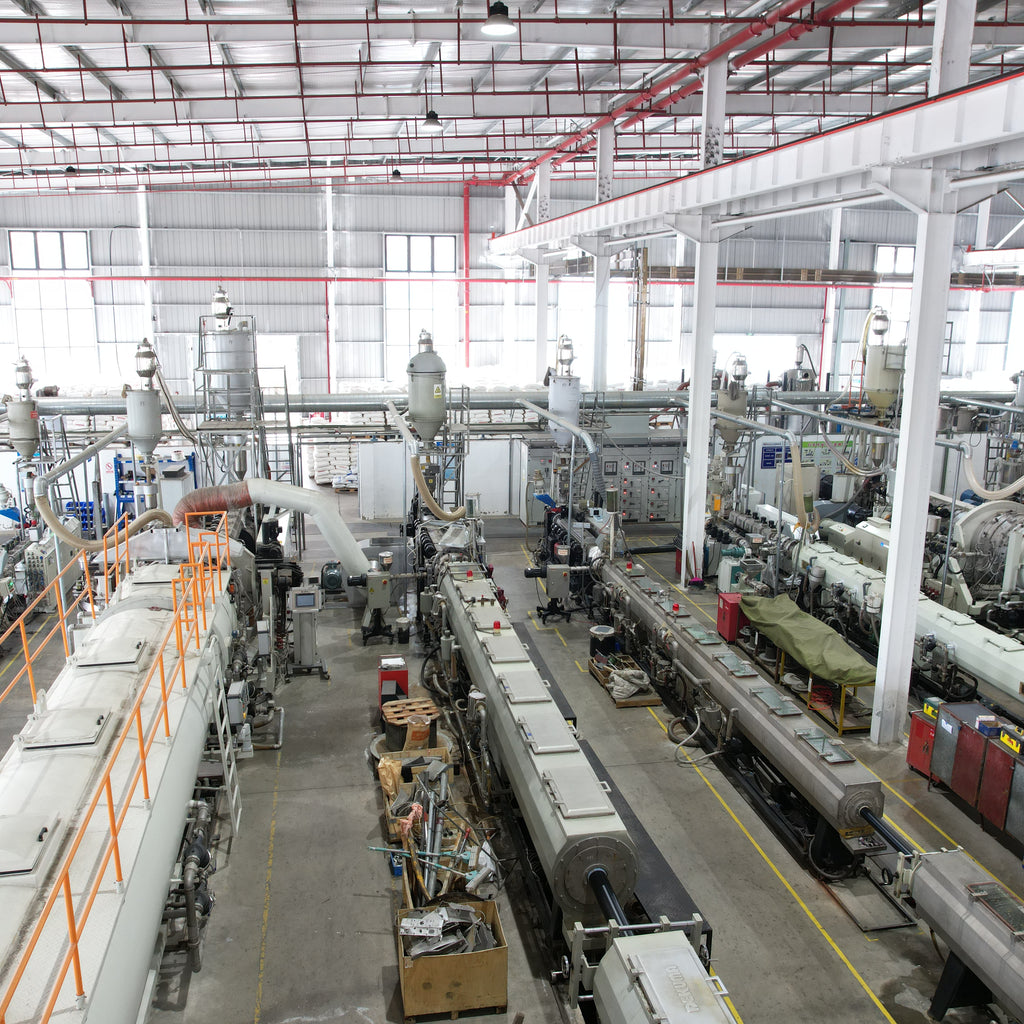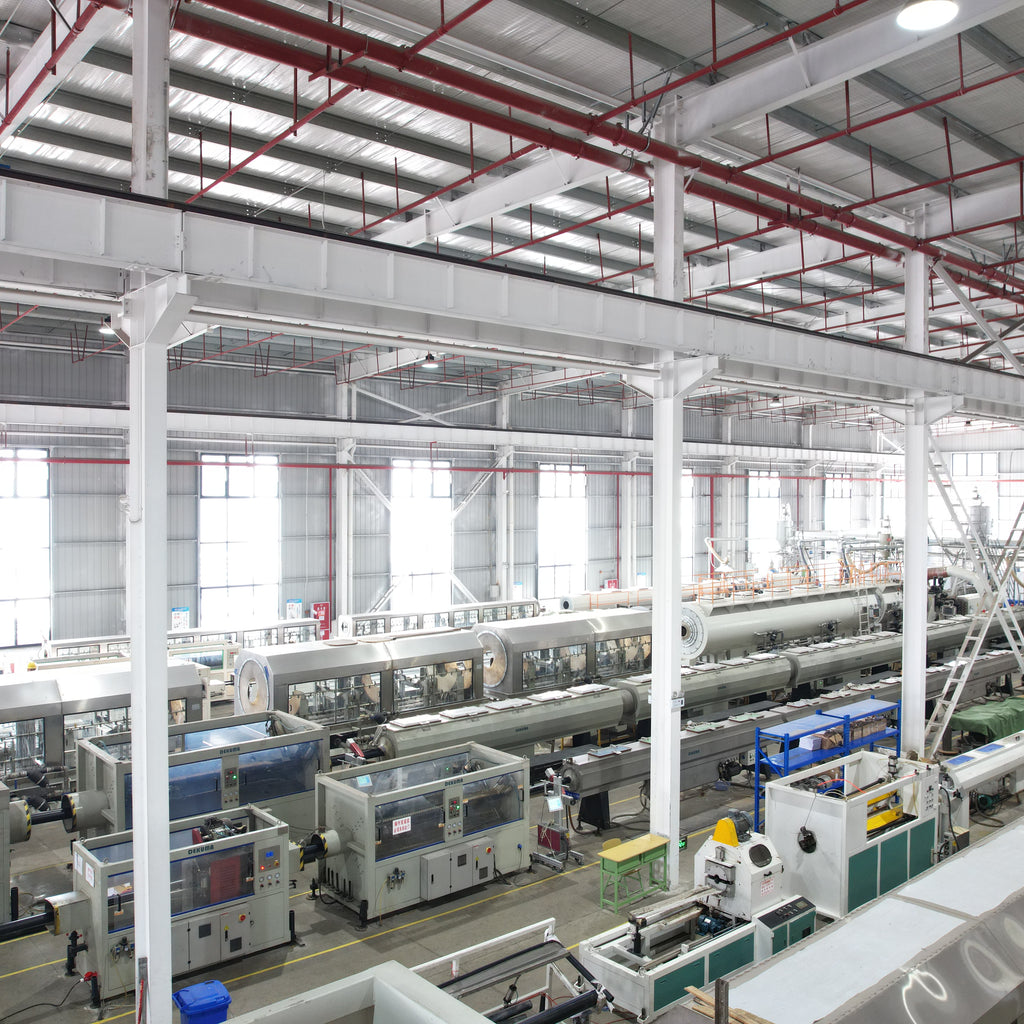以下是为PE 燃气管设计的研究性文章,聚焦耐应力开裂性能优化与长期可靠性,针对燃气管道的安全运行提供系统性解决方案:
—— 基于 GB 15558.1 标准的燃气管道安全保障
PE 燃气管以耐腐蚀、柔韧抗震的特性,占据城镇燃气管道65% 份额(2024 年中国城市燃气协会数据)。但其耐应力开裂性能成为制约长期安全的关键:
- 某燃气公司统计:慢速裂纹增长(SCG)导致的管道失效占58%
- 传统 PE80 管材耐应力开裂时间(F50)仅1000h,无法满足50 年寿命要求
通过
全缺口蠕变试验(FNCT)和扫描电镜(SEM),发现应力开裂分为:
-
裂纹萌生(0-300h):晶界缺陷处产生微裂纹
-
裂纹扩展(300-1500h):银纹化导致材料发白
-
快速断裂(>1500h):裂纹失稳扩展至断裂
| 参数 |
国标要求 |
工程实测值 |
影响程度 |
| 密度 (kg/m³) |
940-960 |
945-955 |
★★★★☆ |
| 熔体流动速率 (MI) |
0.2-0.5g/10min |
0.6-0.8 |
★★★☆☆ |
| 共聚单体含量 (%) |
2.0-3.0 |
1.5-2.0 |
★★★☆☆ |
采用淤浆法 + 气相法双峰聚合工艺,相比传统单峰树脂:
| 材料类型 |
F50(h) |
断裂伸长率 (%) |
耐温等级 (℃) |
| PE80 单峰 |
1200 |
700 |
40 |
| PE100 双峰 |
3500 |
800 |
45 |
| 钢管 |
- |
20 |
200 |
改性突破:
- 高分子量部分提供抗开裂能力,低分子量部分改善加工性
- 结晶度控制在65-70%,减少晶间应力
添加0.5% 纳米蒙脱土(MMT)与1% 弹性体(POE):
| 材料类型 |
缺口冲击强度 (kJ/m²) |
耐应力开裂 F50 (h) |
维卡软化温度 (℃) |
| 纯 PE100 |
18 |
3000 |
121 |
| 复合 PE100 |
25 |
4500 |
124 |
| 交联 PE |
22 |
5000 |
135 |
创新 **“波纹 - 光滑” 复合结构 **(如图 2),相比普通直管:
- 轴向应力降低18%
- 裂纹扩展路径增加30%
- 允许轴向位移 ±8mm
| 连接类型 |
传统工艺 |
优化工艺 |
抗开裂寿命 (年) |
| 电熔连接 |
单加热丝 |
双加热丝 + 冷却控制 |
25 |
| 热熔对接 |
手动调压 |
全自动恒压焊接 |
30 |
根据GB 15558.1-2017,制定管材内控指标:
| 指标 |
国标要求 |
优化后标准 |
测试方法 |
| 耐应力开裂 F50 (h) |
≥1000 |
≥4000 |
FNCT 试验(GB/T 1847-2008) |
| 长期静液压强度 (MPa) |
≥8.0 |
10.0 |
GB/T 6111-2018 |
| 耐快速裂纹扩展 (RCP) |
通过 |
裂纹长度<100mm |
全尺寸试验 |
基于Weibull 分布建立寿命公式:L=λ1ln(1−P1)
其中:
-
λ为失效速率(0.001 / 年)
-
P为可靠度(推荐 0.99)
| 指标 |
PE80 管材 |
优化 PE100 管材 |
标准要求 |
| 工作压力 (MPa) |
0.8 |
1.0 |
- |
| 10 年开裂率 (%) |
5.2 |
0.7 |
≤1.0 |
| 抢修次数 (次 / 年・km) |
0.6 |
0.1 |
- |
嵌入微胶囊修复剂(如图 3),裂纹扩展时释放环氧树脂,修复0.2mm 以下裂缝。
构建BIM+IoT 监测平台,实时预测剩余寿命(精度 ±5%),预警应力集中区域。
结语
本文通过材料改性 + 结构优化 + 寿命预测,构建了 PE 燃气管的安全可靠性体系。作为专业供应商,我们提供:
✅ 高耐应力开裂 PE 燃气管(SDR11-SDR26)
✅ 管道应力分析与寿命评估服务
✅ 第三方开裂性能检测报告
关键词:PE 燃气管、耐应力开裂、长期可靠性、燃气安全、GB 15558
——Safety Assurance for Gas Pipelines Based on GB 15558.1 Standard
PE gas pipes account for 65% of urban gas networks (2024 China Urban Gas Association), but stress crack resistance limits their longevity:
-
Slow crack growth (SCG) causes 58% of failures
- Traditional PE80 has F50=1000h, insufficient for 50-year lifespan
FNCT and SEM reveal three stages:

-
Crack initiation (0-300h): Microcracks at grain boundaries
-
Crack propagation (300-1500h): Craze formation and whitening
-
Rapid fracture (>1500h): Unstable crack growth
| Parameter |
GB Requirement |
Field Measurement |
Influence |
| Density (kg/m³) |
940-960 |
945-955 |
★★★★☆ |
| Melt index (MI) |
0.2-0.5g/10min |
0.6-0.8 |
★★★☆☆ |
| Comonomer content (%) |
2.0-3.0 |
1.5-2.0 |
★★★☆☆ |
Slurry + gas phase bimodal polymerization vs. unimodal:
| Material Type |
F50 (h) |
Elongation at Break (%) |
Temperature Rating (℃) |
| PE80 unimodal |
1200 |
700 |
40 |
| PE100 bimodal |
3500 |
800 |
45 |
| Steel pipe |
- |
20 |
200 |
Breakthroughs:
- High-MW fraction resists cracking, low-MW improves processability
- Crystallinity 65-70% reduces intercrystalline stress
Adding 0.5% MMT + 1% POE:
| Material Type |
Notched Impact Strength (kJ/m²) |
SCG F50 (h) |
Vicat Softening Temp (℃) |
| Pure PE100 |
18 |
3000 |
121 |
| Composite PE100 |
25 |
4500 |
124 |
| Crosslinked PE |
22 |
5000 |
135 |
"Corrugated-smooth" structure (Figure 2):
- Axial stress -18%
- Crack path +30%
- Allows ±8mm axial movement
| Joint Type |
Traditional Method |
Optimized Method |
Crack Resistance (years) |
| Electrofusion |
Single heating wire |
Dual wire + cooling control |
25 |
| Butt fusion |
Manual pressure |
Automatic constant pressure |
30 |
Based on GB 15558.1-2017:
| Parameter |
GB Requirement |
Optimized Standard |
Test Method |
| SCG F50 (h) |
≥1000 |
≥4000 |
FNCT (GB/T 1847-2008) |
| Long-term hydrostatic strength (MPa) |
≥8.0 |
10.0 |
GB/T 6111-2018 |
| RCP resistance |
Pass |
Crack length <100mm |
Full-scale test |
Weibull-based formula:L=λ1ln(1−P1)
Where:
-
λ = failure rate (0.001/year)
-
P = reliability (0.99 recommended)
| Index |
PE80 Pipe |
Optimized PE100 Pipe |
Standard Requirement |
| Operating pressure (MPa) |
0.8 |
1.0 |
- |
| 10-year cracking rate (%) |
5.2 |
0.7 |
≤1.0 |
| Repair frequency (times/year·km) |
0.6 |
0.1 |
- |
Microcapsule repair agent (Figure 3) releases epoxy for ≤0.2mm crack repair.
BIM+IoT platform predicts remaining life (±5% accuracy) and alerts stress concentration zones.
Conclusion
This paper ensures safety through material modification + structural design + life prediction. As a professional supplier, we provide:
✅ High SCG-resistant PE gas pipes (SDR11-SDR26)
✅ Pipe stress analysis and life assessment
✅ Third-party crack testing reports
Keywords: PE gas pipe, stress crack resistance, long-term reliability, gas safety, GB 15558



